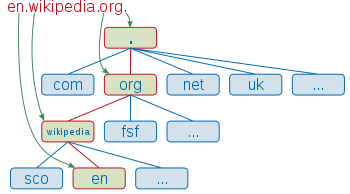Fully qualified domain name
A fully qualified domain name (FQDN), sometimes also referred to as an absolute domain name,[1] is a domain name that specifies its exact location in the tree hierarchy of the Domain Name System (DNS). It specifies all domain levels, including the top-level domain and the root zone.[2] A fully qualified domain name is distinguished by its lack of ambiguity: it can be interpreted only in one way. It usually consists of a host name and at least one higher-level domain (label) separated by the symbol "." and always ends in the top-level domain.

The DNS root domain is unnamed which is expressed by having an empty label in the DNS hierarchy, resulting in a fully qualified domain name ending with the top-level domain. However, in some cases the full stop (period) character is required at the end of the fully qualified domain name.
In contrast to a domain name that is fully specified, a domain name that does not include the full path of labels up to the DNS root is often called a partially qualified domain name.
Syntax
A fully qualified domain name consists of a list of domain labels representing the hierarchy from the lowest relevant level in the DNS to the top-level domain (TLD). The domain labels are concatenated using the full stop “.” character (dot or period) as a separator between labels.
The DNS root is unnamed, expressed as the empty label terminated by the dot. This is most notable in DNS zone files in which a fully qualified domain name must be specified with a trailing dot. For example, somehost.example.com. explicitly specifies an absolute domain name that ends with the empty top level domain label.[3]
Example
A device with the hostname myhost in the parent domain example.com has the fully qualified domain name myhost.example.com. The FQDN uniquely distinguishes the device from any other hosts called myhost in other domains.
Resolution
Many DNS resolvers process a domain name that contains a dot in any position as being fully qualified or add the final dot needed for the root of the DNS tree. Resolvers process a domain name without any dots as unqualified and automatically append the system's default domain name and the final dot.
Some applications, such as web browsers, try to resolve the domain name part of a uniform resource locator (URL) if the resolver cannot find the specified domain or if it is clearly not fully qualified by appending frequently used top-level domains and testing the result. Some applications, however, never use trailing dots to indicate absoluteness, because the underlying protocols require the use of FQDNs, such as the Simple Mail Transfer Protocol (SMTP).[4]
Partially qualified domain name
A partially qualified domain name does not include all labels to the DNS root. Such a name is also known as a relative domain name.[1][5] Relative domain names are often simply hostnames, i.e. the left-most label in a fully qualified name.
References
- RFC 1035, Domain names: implementation and specification
- April N. Marine; Joyce K. Reynolds; Gary Scott Malkin (March 1994). "Questions About the Domain Name System". Answers to Commonly asked "New Internet User" Questions. IETF. sec. 5. doi:10.17487/RFC1594. RFC 1594. Retrieved 29 April 2013.
If you think of the DNS as a tree-structure with each node having its own label, a fully qualified domain name for a specific node would be its label followed by the labels of all the other nodes between it and the root of the tree.
- Fisher, Tim. "FQDN". About.com. Retrieved 20 March 2013.
- "Definition of domain names in Simple Mail Transfer Protocol". Tools.ietf.org. 1998-05-21. Retrieved 2014-01-08.
- "Fully Qualified Domain Name (FQDN) and Partially Qualified Domain Name (PQDN)".
External links
- RFC 1123: Requirements for Internet Hosts - application and support
- RFC 1535: A Security Problem and Proposed Correction With Widely Deployed DNS Software
- RFC 2181: Clarifications to the DNS specification
- RFC 2826: IAB Technical Comment on the Unique DNS Root
- RFC 4703: Resolution of Fully Qualified Domain Name (FQDN) Conflicts among Dynamic Host Configuration Protocol (DHCP) Clients